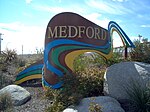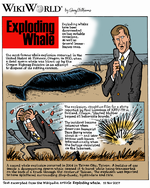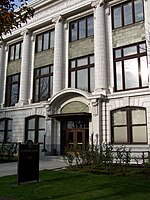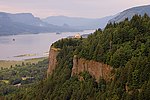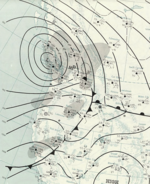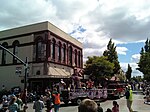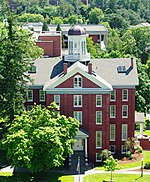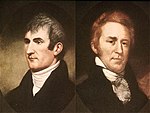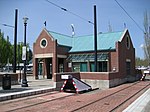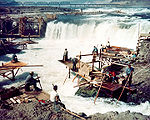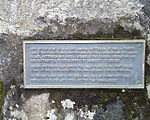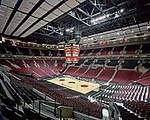
A | B | C | D | E | F | G | H | CH | I | J | K | L | M | N | O | P | Q | R | S | T | U | V | W | X | Y | Z | 0 | 1 | 2 | 3 | 4 | 5 | 6 | 7 | 8 | 9
Usage
The layout design for these subpages is at Portal:Oregon/Selected article/Layout.
- Add a new Selected article to the next available subpage.
- The list should only contain articles that have been given a quality rating of "B" class, or higher.
- All blurbs should have an accompanying free-use image that is relevant to the selected article.
- The "blurb" for all selected articles should be approximately 10 lines, for appropriate formatting in the portal main page.
- Update "max=" to new total for its {{Random portal component}} on the main page.
Selected articles list
Portal:Oregon/Selected article/1
Medford is a city in Jackson County, Oregon. As of 2014, the city had a total population of 78,557 and a metro population of more than 208,000. The city was named in the 1880s by David Loring, a civil engineer working for the Oregon and California Railroad for his home town of Medford, Massachusetts and in recognition of its position on the middle fork of Bear Creek. Medford was incorporated in 1885, and became the county seat of Jackson County in 1927. The Mail Tribune is the primary newspaper, and Rogue Valley International–Medford Airport the main airport. Education is provided by the Medford School District and Rogue Community College. Notable Medford residents include Kirstie Alley, Bill Bowerman, David B. Frohnmayer, Ginger Rogers, and Vic Snyder. Medford uses a council-manager style of government. The governing body of Medford consists of a mayor and eight city council members. Medford is located approximately 27 miles (43 km) north of the northern California border, at 42.3°N. Interstate 5 runs north-south through the center of the city with Oregon Routes 99, 238, and 62 also serving the city. Medford sits in a "weather shadow" between the Cascade Range and Siskiyou Mountains called the Rogue Valley. As such, most of the rain associated with the Pacific Northwest and Oregon in particular skips Medford, making it drier and sunnier than the Willamette Valley. Medford's economy is driven primarily by agriculture (pears, peaches, viticulture grapes) and timber products.
Portal:Oregon/Selected article/2
The New Carissa was a freighter that ran aground on a beach near Coos Bay, Oregon, United States, during a storm in February 1999 and subsequently broke apart. An attempt to tow the bow section of the ship out to sea failed when the tow line broke, and the bow was grounded again. Eventually, the bow was successfully towed out to sea and sunk. The stern section remains on the beach near Coos Bay. Fuel on board the ship was burned off in situ, but a significant amount was also spilled from the wreckage, causing ecological damage to the coastline. The United States Coast Guard performed an investigation and found that captain's error was the main cause of the wreck; however, no criminal liability was established and the captain and crew were not charged. There were significant legal and financial consequences for the ship's owners and insurer. The stern section remained aground for over nine years until it was dismantled and removed from the beach in 2008.
Portal:Oregon/Selected article/3
Exploding whales have been documented on two notable occasions, as well as several lesser-known ones. The most famous explosion occurred in Florence, Oregon in 1970, when a dead sperm whale (originally reported as a gray whale) that had washed ashore was blown up by the Oregon Highway Division in an attempt to dispose of its rotting carcass. This incident became famous in the U.S. when American humorist Dave Barry wrote about it in his syndicated newspaper column after viewing a videotape of television footage of the explosion. It later became well-known internationally when the same footage circulated on the Internet. There have also been spontaneous explosions. The other best-reported case of an exploding whale was in Taiwan in 2004, when a buildup of gas inside a decomposing sperm whale caused it to explode while it was being transported for a post-mortem examination. As exploding whales are an interesting and absurd topic, they have been written about by several authors.
Portal:Oregon/Selected article/4
Ballot Measure 37 was a citizens' initiative passed in 2004, which requires that government compensate owners whose property value has been diminished by land-use regulations, or else waive the regulations. It followed Oregon Ballot Measure 7 passed in 2000 with similar provissions that had been struct down by the Oregon Supreme Court. Measure 37 represents a major change of course from Oregon's legacy of land use planning, and has generated a great deal of controversy. Passage led to many large land owners filing claims across the state that totaled in the millions of dollars each. The controversy surrounding these claims and the possibility of less controlled growth led lawmakers and other groups to propose changes to the law. Changes would exempt many larger developments from the provisions of Measure 37, while explicitly allowing some of the smaller claims, such as families building up to three houses on a single lot. These changes were turned into Measure 49. In a special election in November 2007, Measure 49 was passed by Oregon voters after one of the most expensive campaigns in the state's history.
Portal:Oregon/Selected article/5
The USS Oregon (BB-3) was a pre-Dreadnought Indiana-class battleship of the United States Navy. Her construction was authorized on 30 June 1890, and the contract to build her was awarded to Union Iron Works of San Francisco, California on 19 November 1890. Her keel was laid exactly one year later. She was launched 26 October 1893, sponsored by Miss Daisy Ainsworth, delivered to the Navy 26 June 1896, and commissioned 15 July 1896, under the command of Captain H.L. Howison. Leaving drydock on 16 February 1898, she received news that Maine had blown up in Havana harbor the previous day. As tensions with Spain grew, on 9 March Oregon arrived in San Francisco and loaded ammunition. Three days later she was ordered on what was to become one of the most historic voyages ever undertaken by a Navy ship, sailing over 14,000 miles in 66 days. Despite Oregon's inspiring transit, the realization that the delay would have been cut to some three weeks if the Panama Canal had been operational greatly helped to persuade the United States to buy the failed French operations in Panama and complete the canal.
Portal:Oregon/Selected article/6
The Oregon Supreme Court is the highest state court in the U.S. state of Oregon. The only court that may reverse or modify a decision of the Oregon Supreme Court is the Supreme Court of the United States. The OSC holds court at the Supreme Court building in Salem, Oregon, near the capitol building on State Street. Justices of the court serve six-year terms upon election; however, vacancies are filled by appointments of the Governor of Oregon until the next general election, when any qualified candidate may run for the position including the appointee. Tracing its beginnings back to 1841, when Oregon pioneers selected a supreme judge with probate powers, the court has grown from a single judge to its current make up of seven justices. These seven justices then select one member to serve a six-year term as Chief Justice. The court's Chief Justice is not only responsible for assigning cases to the other justices to write the court's opinions, but is also the chief executive of the Oregon Judicial Department. Primarily an appeals court, it is also the court of last resort in Oregon. Although most oral arguments before the court are held in the Oregon Supreme Court Building (built in 1914), the court does travel around the state, holding sessions in various schools.
Portal:Oregon/Selected article/7
The Oregon Coast Range is a mountain range running north-south in western Oregon that extends over 200 miles from the Columbia River on the border of Oregon and Washington south to the middle fork of the Coquille River in the United States. It is thirty to sixty miles wide and averages around 1,500 feet in elevation. The oldest portions of the range are over 60 million years old, with volcanics and a forearc basin as the primary mountain building processes responsible for the range. It is part of the larger Pacific Coast Range that extends over much of the western edge of North America. The range creates a rain shadow effect for the Willamette Valley that lies to the east of the mountains, creating a more stable climate and significantly less rain than the coastal region of the state. The Oregon Coast Range is divided into three separate sections: Northern, Central, and Southern. In the south is the oldest portion of the range with formation beginning in the Paleocene era with the Roseburg volcanics, while the newest section is the northernmost portion formed first with the Siletz River Volcanics. The Central and Northern sections contain more sedimentary rocks from the mud, silt, sand, and other volcanic debris than the lower Southern section. Also, the Oregon Coast Range is home to over 50 mammal species, over 100 species of birds, and nearly 30 reptile or amphibian species that spent significant portions of their life cycle in the mountains.
Portal:Oregon/Selected article/8
Manifest Destiny was a phrase that expressed the idea that the United States was destined to expand from the Atlantic seaboard to the Pacific Ocean. Advocates of Manifest Destiny believed that expansion was not good, but that it was obvious ("manifest") and certain ("destiny"). It was originally a political catch phrase or slogan used by Democrats in the 1845-1855 period, and rejected by Whigs and Republicans of that era. Manifest Destiny was an explanation or justification for American expansion, or, in some interpretations, an ideology or doctrine which helped to promote the process. The phrase "Manifest Destiny" was first used primarily by Jackson Democrats after 1845 to promote the annexation of much of what is now the Western United States including the Texas Annexation and the Mexican Cession from Mexico, and the Oregon Territory to which both Great Britain and the U.S. laid claim. Not all Americans who believed that the United States was a divinely favored nation thought that it ought to expand. Whigs especially argued that the "mission" of the United States was only to serve as virtuous example to the rest of the world. If the United States was successful as a shining "city on a hill," people in other countries would seek to establish their own democratic republics. Also, the concept had serious consequences for American Indians. The United States purchased land rights by treaty from the Indian tribes. National policy was that Indians had to become "civilized" and abandon hunting and become farmers. Advocates of "civilization" programs believed that the process would greatly reduce the amount of land needed by the Indians, thereby making more land available for purchase by white Americans.
Portal:Oregon/Selected article/9
The Columbia River is a river that flows from the Canadian province of British Columbia, through the U.S. state of Washington, and forms much of the border between Washington and Oregon before emptying into the Pacific Ocean. It is the largest river (measured by volume) flowing into the Pacific from the Western Hemisphere, and is the fourth-largest in North America. It is 1,243 miles (2,000 km) long and drains a 258,000 square miles (670,000 km2) basin. Humans have lived along the river for as many as 10,000 years. Natives enjoyed plentiful salmon, which could be easily caught during their spawning season; Celilo Falls, just east of the Columbia River Gorge, was an important fishing site, and also a regional trading hub, for many millennia. In 1775, Bruno de Heceta became the first European to sight the river's mouth from the Pacific. Spanish, American, and British explorers sought the river, seeking furs to trade and a navigable passage to the east coast of the continent. The river proved elusive until 1792, when American Robert Gray entered the river's mouth and named the river after his ship; and the English captain George Vancouver's crew explored it as far upstream as the Sandy River. Navigation by steamboats, and later by railroads along the river, was crucial to the settlement and trade in the 19th century. The Columbia's heavy flow, and its large elevation drop over a relatively short distance, give it tremendous potential for hydroelectricity generation. 14 dams on the Columbia, and many more on its tributaries, were built in the 20th century. The dams, and other industry near the river, profoundly altered the ecology and economy of the region; today Celilo Falls and other fishing sites have been flooded by lakes, which make up nearly the entire length of the once free-flowing river. The once plentiful salmon now struggle to reach their spawning grounds, and the removal of some of the dams to mitigate their impact on the fish is increasingly under consideration.
Portal:Oregon/Selected article/10
Willamette University is a private institution of higher learning located in Salem, Oregon. Founded in 1842, it is the oldest university in the western United States. Willamette has approximately 2,500 students in four schools, the undergraduate College of Liberal Arts, the graduate level College of Law, Atkinson Graduate School of Management, and the School of Education. The campus is located on 69 acres (250,000 m²) directly south of the Oregon State Capitol. Buildings on campus include Eaton Hall, Smullin/Walton Hall, Collins Hall, Olin Hall, G. Herbert Smith Auditorium, the Fine Arts building, the Hatfield Library, the Mary Stuart Rogers auditorium, Putnam University Center, Gatke Hall, Lausanne Hall, Goudy Commons, Kaneko Commons and Willamette's oldest building, Waller Hall. The university is a NCAA Division III school with the Bearcat as mascot. The university was founded as the Oregon Institute in the days of the Oregon Country by the missionary Jason Lee, who had arrived in the territory in 1834. On February 1, 1842, by-laws were adopted, a board of trustees was elected and thus the school was officially established. The original building of the institute was a three-story frame structure first occupied in 1844. At the time, it was one of the largest structures in the Pacific Northwest. It housed the first session of the state legislature to meet in Salem after the capital was moved there in 1851. The name of institution was changed to "Wallamet University" in 1852.
Portal:Oregon/Selected article/11
Portland State University (PSU) is a public state urban university located in downtown Portland, Oregon. It has the largest overall enrollment of any university in the state. Part of the Oregon University System, it is also the state's only public university that is located in a major metropolitan city. PSU was established as the Vanport Extension Center in 1946 to satisfy the demand for higher education in Portland for returning World War II veterans. In 1952, the Center moved to downtown Portland and occupied the vacated buildings of Lincoln High School. In 1955, the Center changed its name to Portland State College, with graduate programs added in 1961 and doctoral programs added in 1968. The Oregon State System of Higher Education allowed the school to change its name in 1969 to Portland State University. In 1994, PSU eliminated the traditional undergraduate distribution system and adopted a new interdisciplinary general-education program known as University Studies. The Daily Vanguard, the student-run newspaper, was established in 1946. The student-run radio station is KPSU. "The Portland Review" is a literary magazine published by PSU's Student Publications Board. Additional student newspapers at PSU are The Rearguard, an alternative-monthly newspaper, and The Spectator.
Portal:Oregon/Selected article/12
The Columbus Day Storm of 1962 was an extratropical wave cyclone that ranked among the most intense to strike the United States Pacific Northwest since the January 9, 1880, "Great Gale" and snowstorm. On a larger scale, the Columbus Day Storm of 1962 is a contender for the title of most powerful extratropical cyclone recorded in the U.S. in the 20th century. Only hurricanes of Category 3 or higher have brought winds of the magnitude witnessed in Oregon and Washington on Columbus Day, October 12, 1962. A tropical storm named Freda formed about 500 miles/800 km from Wake Island in the central Pacific Ocean. The system became an extratropical cyclone as it moved into colder waters and interacted with the jet stream. This storm moved northeastward, and then hooked straight north as it neared southwest Oregon before moving northward at an average speed of 40 mph (64 km/h) or greater, with the center just off of the Pacific Coast. It made landfall on Vancouver Island, British Columbia, where it weakened rapidly. At the Mt. Hebo Air Force Station in the Oregon Coast Range, the anemometer pegged at its maximum 130 mph (209 km/h) for long periods—likely at the level of a Category 4 hurricane; damage to the radar domes suggested wind gusts to at least 170 mph (270 km/h). At least 46 fatalities were attributed to this storm, more than for any other Pacific Northwest wind event. The dollar damage adjusted to 2002 for inflation and population/property increase suggest a $3 to $5 billion storm.
Portal:Oregon/Selected article/13
Mount Hood (called Wy'east by the Multnomah tribe), is a stratovolcano in the Cascade Volcanic Arc in northern Oregon, in the Pacific Northwest region of the United States. It is located about 50 miles (80 km) east-southeast of the city of Portland, on the border between Clackamas and Hood River counties. Mount Hood's snow-covered peak rises 11,249 ft (3,429 m) and is home to twelve glaciers. It is the highest mountain in Oregon and the fourth-highest in the Cascade Range. Mount Hood is considered the Oregon volcano most likely to erupt, though based on its history, an explosive eruption is unlikely. Still, the odds of an eruption in the next 30 years are estimated at between 3 and 7 percent, so the USGS characterizes it as "potentially active". The mountain is sometimes informally described as "dormant" ("asleep"). Timberline Lodge is a National Historic Landmark located on the southern flank of Mount Hood just below Palmer Glacier. The mountain has six ski areas: Timberline, Mount Hood Meadows, Ski Bowl, Cooper Spur, Snow Bunny and Summit. They total over 4,600 acres (7.2 mi², 18.6 km²) of skiable terrain; Timberline offers the only year-round lift-served skiing in North America. Mount Hood is part of the Mount Hood National Forest, which has 1.067 million acres (1667 mi², 4318 km²), four designated wilderness areas which total 189,200 acres (295 mi², 766 km²), and more than 1200 mi (1900 km) of hiking trails.
Portal:Oregon/Selected article/14
The Oregon State Capitol is the building housing the state legislature and the offices of the governor, secretary of state, and treasurer of Oregon. It is located in the state capital, Salem. The current building, constructed in 1935 and expanded in 1977, is the third to house the Oregon state government since the state administration moved to Salem in 1852. Two former capitol buildings were destroyed by fire, one in 1855 and the other in 1935. New York architects Trowbridge & Livingston conceived the current structure's Art Deco design, in association with Francis Keally. Much of the interior and exterior are made of marble. The Oregon State Capitol was placed on the National Register of Historic Places in 1988. The Public Works Administration, part of the U.S. government, partially financed construction, which was completed during the Great Depression, in 1937. The building was erected at a cost of $2.5 million for the central portion of the building, which includes a dome of 166 feet (51 m).
Portal:Oregon/Selected article/15
Hillsboro is a city in and the county seat of Washington County, Oregon, United States. The community was founded in 1842 and was named Hillsborough in 1850; in 1876 the city was incorporated as Hillsboro. Located in the Tualatin Valley, the city is home to a number of technology companies such as microprocessor chip manufacturers and related suppliers, giving rise to the term Silicon Forest, which includes other high-tech employers in the region. Hillsboro is governed by a council-manager government consisting of a city manager and a city council headed by a mayor. Transportation modes in the city include the T.V. Highway, the Sunset Highway, and the Hillsboro Airport, with public transportation available through TriMet, including MAX Light Rail. The city has four high schools and four middle schools, and is also home to Pacific University's Health Professions Campus. Hillsboro's population was 91,611 as of the 2010 census, making it the most populous city in the county and fifth most populous in the state. The population is approximately 73% White, with those of Hispanic heritage as the largest minority group, comprising approximately 23% of the total population as of the 2010 census. Median household income was $51,737 as of the 2000 census.
Portal:Oregon/Selected article/16
Oregon Route 99W is a state-numbered route in Oregon, United States that runs from OR 99 and OR 99E in Junction City north to I-5 in southwestern Portland. (Some signs continues it north to US 26 near downtown, but most signs agrees with the Oregon Department of Transportation's (ODOT) description, ending it at I-5. 99W is known by ODOT as the Pacific Highway West No. 1W (see Oregon highways and routes); that highway continues north through downtown (along a former extension of OR 99W) to the Pacific Highway No. 1 (I-5) in northern Portland, as well as south on OR 99 to the Pacific Highway (I-5) in Eugene. Until around 1972, OR 99W was U.S. Route 99W, rejoining OR 99E (former US 99E) in northern Portland. US 99 then continued north along present I-5 into Washington; the next segment still numbered 99 is WA 99 south of Seattle. Cities along the highway route include Tigard and Newberg along a mainly east-west alignment near Portland in the Willamette Valley. At McMinnville the road turns south and passes through Monmouth, Corvallis, Monroe, and Junction City before ending in Eugene.
Portal:Oregon/Selected article/17
Crater Lake National Park is a United States National Park whose primary feature is Crater Lake. It was established on May 22, 1902 as the fifth National Park in the U.S., and is Oregon's only National Park. The park encompasses Crater Lake's caldera, which rests in the remains of a destroyed volcano posthumously called Mount Mazama. About 400,000 years ago, Mazama began life as overlapping shield volcanoes. Over time, alternating layers of lava flows and pyroclastic flows built Mazama until it reached about 11000 feet (3400 m) in height. After a period of dormancy, Mazama became active again. Then, around 5700 BC, Mazama collapsed into itself during a tremendous volcanic eruption. The eruption formed a large caldera that was filled in about 740 years, forming a lake with a deep blue hue, known today as Crater Lake. The lake is 1,949 feet (594 m) deep at its deepest point which makes it the deepest lake in the U.S., the second-deepest in North America, and the ninth-deepest anywhere in the world. The caldera rim ranges in elevation from 7000 to 8000 feet (2100 to 2400 m). The USGS benchmarked elevation of the lake surface itself is 6178 ft (1883 m). The park covers 286 mi² (741 km²) with the highest point at Mount Scott. The lake is filled entirely from direct precipitation in the form of snow and rain.
Portal:Oregon/Selected article/18
The Oregon wine industry contributed a total of USD $1.4 billion to the Oregon economy. Of that figure, over USD $800 million is directly provided by wineries and vineyards via sales, wages, and spending. It is estimated that the industry contributed 8,479 wine-related jobs and USD $203 million in wages. Exports to other states in 2004 were USD $64.1 million. Out of all US wine growing regions, Oregon ranked third in number of wineries and fourth in production. Nearly 1.6 million cases of Oregon wine were sold in 2005. The retail value of these cases was $184.7 million, a 24% increase over the previous vintage. Wine has been produced in Oregon since the Oregon Territory was settled in the 1840s; however, winemaking has only been a significant industry in the state since the 1960s. Grapes were first planted in the Oregon Territory in 1847, with the first recorded winery being established in 1850 in Jacksonville. Throughout the 19th century, there was experimentation with various varietals by immigrants to the state, and in 1904, an Oregon winemaker won a prize at the St. Louis World's Fair. There are three main wine producing regions with a major presence in the state of Oregon. Two of them, the Willamette Valley AVA and the Southern Oregon AVA, are wholly contained within Oregon; a third, the Columbia Gorge AVA straddles the Columbia River and includes territory in both Oregon and Washington.
Portal:Oregon/Selected article/19
Moda Center, previously known as the Rose Garden arena, is the primary indoor sports arena in Portland, Oregon. It is suitable for large indoor events of all sorts, including basketball, ice hockey, rodeos, circuses, conventions, ice shows, concerts, and dramatic productions. The arena has a capacity of 19,980 spectators when configured for basketball; it holds smaller crowds when configured for other events. The arena is equipped with state-of-the-art acoustics and other amenities. It is owned by Vulcan Inc., a holding company owned by Paul Allen, and is currently managed by Global Spectrum, a company which manages sports facilities (and which also owns several sports franchises). The primary tenant is the Portland Trail Blazers NBA franchise, also owned by Allen. Several other professional sports franchises, and the Portland State University men's basketball team, either currently play home games in the Moda Center, or have done so in the past. In addition, the facility is a popular venue for concerts and other artistic productions. Construction of the arena began in 1993, and the facility opened on October 12, 1995, named the Rose Garden. The arena cost US $262 million to build; construction was financed with funds obtained from a variety of sources, including the City of Portland, Allen's personal fortune, and $155 million in bonds issued by a consortium of mutual funds and insurance companies. The Rose Garden arena was renamed Moda Center in 2013, under a 10-year naming rights deal with Moda Health.
Portal:Oregon/Selected article/20
Willamette University College of Law is a private law school located in Salem. Founded in 1842, Willamette University is the oldest university in the Western United States. The College of Law, which was founded in 1883 and is the oldest law school in the Pacific Northwest, has approximately 30 law professors and a yearly entering class of 165 students. The campus is located across the street from the Oregon State Capitol and the Oregon Supreme Court Building. Housed in the Truman Wesley Collins Legal Center, Willamette's College of Law offers full-time enrollment for the Juris Doctor (J.D.) degree, a joint-degree program, and a Master of Laws (LL.M.) program. Students may attend part time for the LL.M. program, which focuses on international legal issues. The joint-degree program allows students to earn both a J.D. and a Master of Business Administration (M.B.A.) concurrently in a four-year program.
Portal:Oregon/Selected article/21
The 1985 Rajneeshee assassination plot was a conspiracy by high-ranking followers of Bhagwan Shree Rajneesh (now known as Osho) to assassinate Charles Turner, the then-United States Attorney for the District of Oregon. Osho's chief lieutenant, Ma Anand Sheela, assembled the hit squad after Turner was appointed to investigate illegal activity at Rajneeshpuram. Turner headed an investigation into the 1984 Rajneeshee bioterror attack in The Dalles, Oregon, and also investigated charges of wiretapping, immigration fraud and sham marriages. The conspirators obtained false identification to purchase handguns out-of-state, stalked Turner, and planned to kill him near his workplace in Portland, Oregon. The assassination plot was uncovered as a result of an investigation by federal law enforcement into the bioterror attack in The Dalles, and Turner was never harmed. Prosecution of the conspirators began in 1990, when a federal grand jury brought indictments against several of the key players. Some had fled the country, and extradition proceedings against the perpetrators and subsequent prosecution and conviction was not completed for sixteen years. The final conspirator was convicted in 2006, when Catherine Jane Stork agreed to return to the United States from Germany in order to be allowed to visit her ill son in Australia. The perpetrators received sentences ranging from five years probation to five years in federal prison.
Portal:Oregon/Selected article/22
The 1980 eruption of Mount St. Helens was the most significant volcanic eruption to occur in the lower 48 states of the United States in recorded history. The eruption was preceded by a two-month long series of earthquakes and steam venting episodes that created a huge bulge and a fracture system on Mount St. Helens' north slope. An earthquake on May 18, 1980 caused the entire weakened north face to slide away, suddenly exposing the partly molten, gas and steam-rich rock in the volcano to lower pressure. The rock responded by exploding into a super-heated mix of pulverized lava and older rock that sped toward Spirit Lake so fast that it quickly passed the avalanching north face. By the time the ash settled and the lahars stopped advancing, 57 people were dead, many thousands of animals were killed, hundreds of square miles were reduced to a wasteland, and over a billion U.S. dollars in damage was done. Additionally, large mud flows created by the blast flowed into area rivers and made their way to the Columbia River. This resulted in 13-foot (4 m) river depths on the Columbia, and temporarily closed the busy channel to ocean-going freighters, costing Portland an estimated five million US dollars. Portland mayor Connie McCready eventually threatened local businesses with fines if they failed to remove the ash that had accumulated from three blasts from their parking lots.
Portal:Oregon/Selected article/23
The Columbia River Basalt Group is a large igneous province that lies across parts of the states of Washington, Oregon, and Idaho in the United States. During late Miocene and early Pliocene times, one of the largest flood basalts ever to appear on the earth's surface engulfed about 163,700 km² (63,000 mile²) of the Pacific Northwest, forming a large igneous province with an estimated volume of 174,300 km³. Eruptions were most vigorous from 17—14 million years ago, when over 99% of the basalt was released. Less extensive eruptions continued from 14—6 million years ago. These lava flows have been extensively exposed by the erosion resulting from the Missoula Floods, which laid bare many layers of the basalt flows at Wallula Gap, the lower Palouse River, the Columbia River Gorge and throughout the Channeled Scablands. Over a period of perhaps 10 to 15 million years lava flow after lava flow poured out, eventually accumulating to a thickness of more than 1.8 km (6,000 feet). The subsidence of the crust produced a large, slightly depressed lava plain now known as the Columbia Basin or Columbia River Plateau. Flowing from modern Eastern Oregon, the flows would make it as far as the modern Oregon Coast and form portions of the Oregon Coast Range. The ancient Columbia River was forced into its present course by the northwesterly advancing lava. The lava, as it flowed over the area, first filled the stream valleys, forming dams that in turn caused impoundments or lakes. In these ancient lake beds are found fossil leaf impressions, petrified wood, fossil insects, and bones of vertebrate animals.
Portal:Oregon/Selected article/24
Eugene is the county seat of Lane County, Oregon. It is located at the south end of the Willamette Valley, at the confluence of the McKenzie and Willamette rivers, about 60 miles (97 km) east of the Oregon Coast. According to the official 2007 population figures Eugene is the second-largest city in Oregon, with an estimated population of 153,690, and the third-largest metropolitan population. Eugene was long the state's second-largest city after Portland, but was overtaken by Salem in terms of population from around 2004 to 2006. Eugene is named after its founder, Eugene Franklin Skinner, who in 1846 erected the first cabin in the area. The first post office was registered on January 8, 1850 and the city was incorporated in 1862. Eugene is home to the University of Oregon's main campus, which is downtown. The city is also noted for its natural beauty, activist political leanings, alternative lifestyles, recreation opportunities (especially bicycling, rafting, and kayaking), and arts focus. Eugene's motto is "The World's Greatest City of the Arts and Outdoors." In addition to the university-owned cultural facilities, the city is home to the Hult Center for the Performing Arts and The John G. Shedd Institute for the Arts. It is also referred to as "The Emerald Empire," "The Emerald City," "The People's Republic of Eugene," and "Track Town, USA" or "The Track Capital of the World." The Nike corporation had its beginnings in UO's track program. Eugene's largest industries are wood products manufacturing and recreational vehicle manufacturing, and the city is home to the corporate headquarters of employee-owned Bi-Mart.
Portal:Oregon/Selected article/25
The Hallie Ford Museum of Art (HFMA) is the museum of Willamette University in Salem. The museum is named after philanthropist Hallie Ford (1905-2007) who donated millions of dollars to the school. When it opened the museum was the second largest art museum in the state after the Portland Art Museum, and it is currently the state's third largest. Opened in 1998, the facility is across the street from the Oregon State Capital in downtown Salem, on the western edge of the Willamette University campus. Hallie Ford exhibits collections of both art and historical artifacts with a focus on Oregon related pieces of art and artists in the 27,000 square feet (2,500 m2) facility. The museum also hosts various traveling exhibits in two of its six galleries. The museum is in a three story, International Style building constructed in 1965 for the local phone company. Past exhibits have included traveling exhibits on Egyptian art in 2002, Maori artwork, a collection of ancient glass work in 2007, and an exhibit on ancient Roman and Greek artifacts. Artists featured include painter Michael Spafford, Michael Brophy, Amanda Snyderis, Rick Bartow, Jacob Lawrence, David Giese, Fay Jones, David Gilhooly, Mary Lou Zeek, and Robert Hess among others. Hallie Ford Museum of Art is a member of both the American Association for State and Local History, and the American Association of Museums
Portal:Oregon/Selected article/26
Yasui v. United States, 320 U.S. 115 (1943) was a United States Supreme Court case regarding the constitutionality of curfews used during World War II as applied to citizens of the United States. The case arose out of the implementation of Executive Order 9066 by the U.S. military to create zones of exclusion along the West Coast of the United States where Japanese-Americans were subjected to curfews and eventual removal to relocation centers. This Presidential order followed the Japanese Attack on Pearl Harbor in 1941 that brought American in to World War II and inflamed the existing anti-Japanese sentiment in the country. In their decision, the Supreme Court held that the application of curfews against citizens is constitutional. As a companion case to Hirabayashi v. United States, both decided on June 21, 1943, the court affirmed the conviction of Oregon-born Minoru Yasui who had violated curfew in Portland. The court remanded the case back to the United States District Court for the District of Oregon for sentencing as this lower court had determined the curfew was not valid against citizens, but Yasui had forfeited his citizenship by working for the Japanese consulate. The Yasui and Hirabayashi decisions, along with the later Ex parte Endo and Korematsu v. United States decisions determined the legality of the curfews and relocations during the war. In the 1980s new information was used to vacate the conviction of Minoru Yasui.
Portal:Oregon/Selected article/27
The Hood to Coast Relay is a unique long-distance relay race held in the U.S. state of Oregon, annually in late August, traditionally on the Friday and Saturday of the weekend before the Labor Day weekend. It is the longest major relay in North America and the largest in the world in terms of total participation (12,000 participants annually). The course runs 197 miles (317 km) from Timberline Lodge on the slopes of Mount Hood, the tallest peak in Oregon, through the Portland metropolitan area, and across the Oregon Coast Range to the city of Seaside on the Oregon Coast. The first relay was held in 1982 and drew eight teams, but due to growth is now limited to 1,000 twelve-person teams. Teams in Hood to Coast must complete the course within a 31 hour time limit (an average of 9 minutes 30 seconds a mile). Walkers and high school teams may choose to compete in the Portland to Coast Walk or Portland to Coast High School Challenge respectively, both of which are held in conjunction with the main relay and start in downtown Portland instead of Mount Hood. Portland to Coast Walk and High School Challenge are limited to 400 and 50 teams respectively; entries are accepted on a first-come-first-served basis until all spaces are filled.
Portal:Oregon/Selected article/28
The Northern Oregon Coast Range is the northern section of the Oregon Coast Range located in the northwest portion of the state. This section of the mountain range, part of the Pacific Coast Ranges, contains peaks as high as 3,661 feet (1,116 m) for Rogers Peak. Forests in these mountains are considered to be some of the most productive timber land in the world. The Central Oregon Coast Range is directly south of this section with the Southern Oregon Coast Range beyond the central range. Approximately 40 million years ago the mountain building processes began during the Eocene age. During this time sandstone and siltstone were formed and basalt flows invaded the area from what is now Eastern Oregon. These rock formations were then lifted as part of the fore-arc basin that runs along the Oregon Coast. Heavy precipitation in the range has further shaped the mountains through erosional forces. The moist and mild climate has helped to create a temperate forest with large stands of Douglas-fir, Sitka spruce, western redcedar, and western hemlock.
Portal:Oregon/Selected article/29
Intel Corporation is the world's largest semiconductor company and the inventor of the x86 series of microprocessors, the processors found in most personal computers. Founded in 1968 as Integrated Electronics Corporation and based in Santa Clara, California, USA, Intel also makes motherboard chipsets, network cards and ICs, flash memory, graphic chips, embedded processors, and other devices related to communications and computing. Founded by semiconductor pioneers Robert Noyce and Gordon Moore, Intel combines advanced chip design capability with a leading-edge manufacturing capability. Originally known primarily to engineers and technologists, Intel's successful "Intel Inside" advertising campaign of the 1990s made it and its Pentium processor household names. While Intel created the first commercial microprocessor chip in 1971, it was not until the creation of the personal computer (PC) that this became their primary business. During the 1990s, Intel invested heavily in new microprocessor designs and in fostering the rapid growth of the PC industry. During this period Intel became the dominant supplier of microprocessors for PCs, and was known for aggressive and sometimes controversial tactics in defense of its market position, as well as a struggle with Microsoft for control over the direction of the PC industry. The 2007 rankings of the world's 100 most powerful brands published by Millward Brown Optimor showed the company's brand value falling 10 places – from number 15 to number 25. Intel is the largest employer in Oregon, with facilities mainly in Hillsboro where it employs over 16,000 at three main locations.
Portal:Oregon/Selected article/30
Waller Hall is the oldest building on the campus of Willamette University in Salem. Built in 1867 as University Hall, the five-story, brick structure was added to the National Register of Historic Places in 1975. The building has been gutted twice by fires with the interior rebuilt each time, and went through renovations in 1987–1989 and 2005. From 1872 when the Oregon Institute building burned down until 1906 the building was the only permanent structure on campus. Built in the Renaissance style of architecture, it is currently used for administration offices and is the oldest university building west of the Mississippi River in the U.S. still in use. Waller Hall is located on the north end of campus opposite the Oregon State Capitol building across State Street. All of the bricks used in the construction were fired on campus using clay excavated from the construction site in order to build the foundation. The school renamed the building in 1912 to Waller Hall in honor of longtime university trustee Alvin F. Waller. Waller is used for administrative functions, including housing the office of the university's president (as of 2008 M. Lee Pelton), and contains the Cone Chapel.
Portal:Oregon/Selected article/31
The Provisional Government of Oregon was a popularly-elected government created in the Oregon Country, in the Pacific Northwest region of North America. It existed from May 2, 1843 until March 3, 1849. Created at a time when no country had sovereignty over the region, this independent government provided a legal system and a common defense for pioneers settling the region. As laid out in Section 1 of the preamble to the Organic Laws of Oregon, which were adopted in 1843 to serve as a constitution, settlers only agreed to the laws “until such time as the United States of America extend their jurisdiction over us.” The government had three branches that included a legislature, judiciary, and executive branch. The executive branch was first the Executive Committee, consisting of three members, in effect from 1843 to 1845; in 1845, a single governor position was created. The judicial branch had a single supreme judge along with several lower courts, and a legislative committee of nine served as a legislature until 1845 when the Oregon House of Representatives was established. The government was superseded when the United States created the Oregon Territory in 1848. Once the territorial government arrived in 1849, the Provisional Government was dissolved, though all but one law continued in effect in the territory.
Portal:Oregon/Selected article/32
The Portland Aerial Tram is an aerial tramway in Portland, Oregon carrying commuters between the city's South Waterfront district and the main Oregon Health & Science University (OHSU) campus, located in the Marquam Hill neighborhood. It is the second commuter aerial tramway in the United States (after New York City's Roosevelt Island Tramway). The tram travels a horizontal distance of 3,300 feet (5/8 mi, 1 km) and a vertical distance of 500 feet (150 m) in a ride that lasts three minutes. The tram was jointly funded by OHSU, the City of Portland, and by South Waterfront property owners, with the bulk of the funding coming from OHSU. It is owned by the city and operated by OHSU. While the majority of passengers are affiliated with OHSU, it is open to the public and operated as part of Portland's public transportation network that includes the Portland Streetcar, MAX Light Rail, and TriMet buses. After opening in December 2006, the tram carried its one millionth passenger on October 17, 2007. The tram cost $57 million to build—a nearly fourfold increase over initial cost estimates, which was one of several sources of controversy concerning the project. A round-trip tram ticket costs $4.50; the tram is free for OHSU employees, patients, students, and visitors.
Portal:Oregon/Selected article/33
The Cascade Range is a major mountain range of western North America, extending from southern British Columbia through Washington and Oregon to Northern California. Running it a north-south direction, it includes both non-volcanic mountains, including the rugged spires of the North Cascades, and the notable volcanoes known as the High Cascades. The Cascades are part of the Pacific Ring of Fire, the ring of volcanoes and associated mountains around the Pacific Ocean. All of the known historic eruptions in the contiguous United States have been from Cascade volcanoes. The two most recent were Lassen Peak in 1914 to 1921 and a major eruption of Mount St. Helens in 1980. Minor eruptions of Mount St. Helens have also occurred, most recently in 2006. In Oregon, the range divides the state between the drier Eastern Oregon section that has a rain-shadow effect and the moister western portion of the state that includes the Willamette Valley and Portland area. Mount Hood, the tallest peak in Oregon at 11,249 feet (3,429 m), is the northernmost volcano in the Oregon section of the Cascades. Other Oregon peaks in the range include Mount Jefferson, Three Fingered Jack, Mount Washington, Three Sisters, Mount Bachelor, Mount Thielsen, Mount Mazama, and Mount McLoughlin among others. The Pacific Crest Trail runs the length of the range, while Oregon's lone national park, Crater Lake National Park, and several national forests and wilderness areas occupy large tracts of land in the mountains.
Portal:Oregon/Selected article/34
The 1984 Rajneeshee bioterror attack refers to the salmonella food poisoning of over seven hundred and fifty individuals in Oregon, USA through the contamination of salad bars at ten local restaurants. Followers of Osho, then known as Bhagwan Shree Rajneesh, hoped to incapacitate the voting population of the town so that their own candidates would win county elections. The attack is one of only two confirmed terrorist uses of biological weapons to harm humans. Having previously gained political control of Antelope, Oregon, Osho followers based in nearby Rajneeshpuram sought election to two of the three seats on the Wasco County Court which were up for election in November 1984. After other tactics to gain political control failed, Rajneeshpuram officials decided to incapacitate voters in The Dalles, the most populated city in the county. The biological agent used was Salmonella enterica Typhimurium, which was first delivered through glasses of water to two county commissioners, and then delivered on a larger scale at salad bars and in salad dressing. A total of 751 people were sickened with salmonellosis, and 45 were hospitalized, but no fatalities. An initial investigation by the Oregon Public Health Division and the Centers for Disease Control did not rule out deliberate contamination, the source of the biological agent was only discovered one year later. At a press conference in 1985, Osho accused several of his followers of involvement in this and other crimes, including an aborted plan to assassinate a United States attorney. The Oregon Attorney General set up an inter agency task force between the Oregon State Police and the Federal Bureau of Investigation, and executed search warrants in Rajneeshpuram. A contaminant matching the bacteria that sickened the town residents was found in a Rajneeshpuram medical laboratory. Two leading Rajneeshpuram officials served twenty-nine months in a minimum-security federal prison.
Portal:Oregon/Selected article/35
The Provisional Legislature of Oregon was the single-chamber legislative body of the Provisional Government of Oregon. It served the Oregon Country of the Pacific Northwest of North America from 1843 until early 1849 at a time when no country had sovereignty over the region. This democratically elected legislature became the Oregon Territorial Legislature when the territorial authorities arrived after the creation of the Oregon Territory by the United States in 1848. The body was first termed the Legislative Committee and later renamed the House of Representatives. Over the course of its six-year history the legislature passed laws, including taxation and liquor regulation, and created an army to deal with conflicts with Native Americans. Many of the legislators would become prominent figures during the territorial years of Oregon. At first a small committee of nine, the group was altered when the Organic Laws of Oregon were revised in 1845 and became the Oregon House of Representatives with a minimum of 13 members. Once the government was dissolved, all the laws remained in effect, except for the one that authorized the minting of coins. Governor Joseph Lane nullified that law ending production of the Beaver Coins.
Portal:Oregon/Selected article/36
Portland is a city located near the confluence of the Willamette and Columbia rivers in the U.S. state of Oregon. With a population of 583,776 (as of the 2010 census), it is Oregon's most populous city, and the third most populous city in the Pacific Northwest, after Seattle, and Vancouver. Approximately 2.3 million people live in the Portland metropolitan area (MSA), the 19th most populous in the United States as of July 2012. Portland was incorporated in 1851 and is the seat of Multnomah County. The city extends slightly into Washington County to the west and Clackamas County to the south. It is governed by a commission-based government headed by a mayor and four other commissioners. Portland's first mayor was Hugh O'Bryant, who served for one year. The city and region are noted for strong land-use planning and investment in public transit, supported by Metro, a distinctive regional-government scheme. Portland lies in the Marine West Coast climate region, which is marked by warm summers and rainy but temperate winters. This climate is ideal for growing roses, and for more than a century Portland has been known as "The City of Roses," with many rose gardens – most prominently the International Rose Test Garden. Portland is also known for its large number of microbreweries, and as the home of the Trail Blazers NBA basketball team.
Portal:Oregon/Selected article/37
The Lewis and Clark Expedition (1804–1806), was headed by Meriwether Lewis and William Clark. It was the first American overland expedition to the Pacific coast and back. In 1804, the Louisiana Purchase sparked interest in expansion to the west coast. A few weeks after the purchase, President Thomas Jefferson, an advocate of western expansion, had the Congress appropriate $2,500 for an expedition. The American expedition to the Pacific northwest was intended to study the Indian tribes, botany, geology, Western terrain and wildlife in the region, as well as evaluate the potential interference of British and French Canadian hunters and trappers who were already well established in the area. Jefferson selected Captain Meriwether Lewis to lead the expedition, afterwards known as the Corps of Discovery. Lewis selected William Clark as his partner, with 31 others rounding out the group. After beginning the expedition in Spring 1804, they traveled up the Missouri River and built Fort Mandan in present day North Dakota for the first winter. The Corps of Discovery then crossed the Rocky Mountains and journeyed down the Columbia River to the Oregon Coast, arriving at the Pacific Ocean in November 1805. The second winter was spent at Fort Clatsop in present day Oregon where they prepared for the journey home. Leaving Fort Clatsop in April 1806, they reached St. Louis on September 23, 1806, ending the expedition.
Portal:Oregon/Selected article/38
The Hillsboro Civic Center is a government-built, mixed-use development in downtown Hillsboro. The development includes the city hall of Hillsboro, which is the county seat of Washington County, located west of Portland. Covering six acres, the Civic Center has a total of over 165,000 square feet (15,300 m2) in the complex. The total of six stories for the main structure makes the building the tallest in the city, tied with Tuality Community Hospital. In addition to government offices, the Civic Center includes retail space, public plazas, and residential housing. The complex was built to centralize city government functions under one roof, allowing the city to move many offices from leased space in the county's Public Services Building. Design of the complex began in 2002, with construction beginning in 2003. After completion in 2005, the building was awarded the LEED Gold certification for sustainability, the second city hall in the United States to earn that distinction. Environmentally friendly technologies used include occupancy sensors, ventilation that monitors carbon dioxide levels to determine when to activate, high performance exterior glass to reduce heat loss, and solar panels to generate electricity. Other features of the complex include conference space, public plazas, outdoor fountains, and an auditorium used for city council meetings, among other items.
Portal:Oregon/Selected article/39
The Oregon Coast is a geographical term that is used to describe the coast of Oregon along the Pacific Ocean. Stretching 362 miles from Astoria to the California border, the beaches along the Oregon Coast are considered public land. Oregon law prohibits private ownership of beaches. The Oregon Coast is often divided into three regions: The North Coast - from the Washington border at Astoria to Lincoln City; The Central Coast - from Lincoln City to Reedsport; The Southern Coast - from Reedsport to the California border, just south of Brookings. There are no large cities on the coast, mainly due to the lack of deep harbors with access to the inland agricultural areas. The largest metro area is Coos Bay/North Bend on the South Coast, which together make up a population of 25,000. The relative isolation of the coast from nearby large population centers has given the coast a reputation for being somewhat rustic, being a mixture of old logging towns, fishing villages, seasonal resorts, and artists' colonies. Tourism and logging are the major industries on the coast. The coastal region's popularity, combined with the fact that there is only one continuous highway along the coastline (U.S. Route 101) contributes to traffic along the coast being named the worst tourist traffic in the United States. Features along the coast include the Oregon Dunes National Recreation Area, Oregon Coast National Wildlife Refuge Complex, Sea Lion Caves, Yaquina Bay, many bridges, more than ten lighthouses, and part of the Lewis and Clark National and State Historical Parks at Fort Stevens at the northernmost portion where the coast meets the Columbia River.
Portal:Oregon/Selected article/40
U.S. Route 199 is a U.S. Highway in the states of California and Oregon, numbered as a spur of U.S. Route 99, which no longer exists. It stretches 80 miles (129 km) from Interstate 5 in Grants Pass, Oregon southwest to U.S. Route 101 near Crescent City, California, and is the northern part of the Redwood Highway. In Oregon, US 199 is officially known as the Redwood Highway No. 25 (see Oregon highways and routes). The entire length in California is part of the California Freeway and Expressway System (although it is almost completely a two-lane road), is eligible for the State Scenic Highway System, and is defined by Streets and Highways Code section 499. US 199 leaves California at the Elk Valley where it leaves the Rogue River-Siskiyou National Forest and descends into the Illinois Valley. After passing O'Brien and the west end of Oregon Route 46 in Cave Junction, the highway leaves the Illinois River north of Cave Junction, with the river then curving west towards the ocean. US 199 then and follows several small creeks past Selma to Hayes Hill Summit (elevation about 1700 feet/500 m). The highway descends from the summit alongside Slate Creek past Wonder and Wilderville and ends up in the Rogue River Valley, where it enters Grants Pass and terminates at Interstate 5.
Portal:Oregon/Selected article/41
The Barlow Road (at inception, Mount Hood Road) is a historic road over and around Mount Hood. It was built in 1846 by Sam Barlow and Philip Foster, with authorization of the Provisional Legislature of Oregon, and served as the last overland segment of the Oregon Trail. Its construction allowed covered wagons to cross the Cascade Range and reach the Willamette Valley, which had previously been nearly impossible. Even so, it was by far the most harrowing 100 miles (160 km) of the nearly 2,000-mile (3,200 km) Oregon Trail. Before the opening of the Barlow Road, pioneers traveling by land from the east followed the Oregon Trail to Wascopam Mission (now The Dalles) and floated down the Columbia River to Fort Vancouver, then a perilous and expensive journey. It was also possible to drive livestock over Lolo Pass on the north side of Mount Hood, but that trail was too rugged for vehicles and so unsuitable for wagons. The Barlow Road begins at The Dalles and heads south to Tygh Valley (some consider Tygh Valley to be the beginning), then turns west and roughly parallels the White River on the north and then west, crosses the south shoulder of Mount Hood at Barlow Pass, follows Camp Creek and the Sandy River for some way, and finally leads to Oregon City. The road was rendered largely irrelevant in the early 1900s by the construction of the Mount Hood Highway. It still exists as a dirt road in some places, while most other parts have been paved over by modern streets and highways.
Portal:Oregon/Selected article/42
Johnson Creek is a tributary, about 25 miles (40 km) long, of the Willamette River in the Portland metropolitan area. Part of the drainage basin of the Columbia River, its watershed consists of 54 square miles (140 km2) of mostly urban land occupied by about 175,000 people as of 2006. Passing through the cities of Gresham, Portland, and Milwaukie, the creek flows generally west from the foothills of the Cascade Range through sediments deposited by glacial floods on a substrate of basalt. Though polluted, it is free-flowing along its main stem and provides habitat for salmon and other migrating fish. Prior to European settlement, the watershed was covered with Oregon ash, alder, and western redcedar forests and scattered black cottonwood groves in riparian areas; Douglas-fir and Oregon white oak grew in the uplands. Native Americans of the Chinook band fished and hunted in this area, and they used fire to maintain prairie openings for native plant foods such as camas. In the 19th century, the watershed was taken over by white settlers who altered the landscape. The stream is named for one of these newcomers, William Johnson, who in 1846 built a water-powered sawmill in what later became the Lents neighborhood of Portland. Data from the United States Geological Survey (USGS) show that the creek reached or exceeded flood stage 37 times between 1941 and 2006. The creek's watershed includes the subwatersheds of Badger Creek, Sunshine Creek, Kelley Creek, Mitchell Creek, Veterans Creek, Crystal Springs Creek, and smaller streams. Parks along the creek and its tributaries include natural areas, a wildlife refuge, a rhododendron garden, a botanical garden, and a 21-mile (34 km) bicycle and pedestrian rail trail that follows the creek for much of its length.
Portal:Oregon/Selected article/43
The Hanford Site is a decommissioned nuclear production complex on the Columbia River in south-central Washington operated by the United States government. Established in 1943 as part of the Manhattan Project, it was home to the B-Reactor, the first full-scale plutonium production reactor in the world. Plutonium manufactured at the site was used in the first nuclear bomb, tested at the Trinity site, and in Fat Man, the bomb detonated over Nagasaki, Japan. During the Cold War, the project was expanded to include nine nuclear reactors and five massive plutonium processing complexes, which produced plutonium for most of the 60,000 weapons in the U.S. nuclear arsenal. Government documents have since confirmed that Hanford's operations released significant amounts of radioactive materials to the air and to the Columbia River, which threatened the health of residents and ecosystems. The weapons production reactors were decommissioned at the end of the Cold War, but the manufacturing process left behind 53 million U.S. gallons (204,000 m³) of high-level radioactive waste that remains at the site. This represents two-thirds of the nation's high-level radioactive waste by volume. Today, Hanford is the most contaminated nuclear site in the U.S. and is the focus of the nation's largest environmental cleanup. While most of the current activity at the site is related to the cleanup project, Hanford also hosts a commercial nuclear power plant, the Columbia Generating Station, and various centers for scientific research and development, such as the Pacific Northwest National Laboratory and the LIGO Hanford Observatory.
Portal:Oregon/Selected article/44
The Hatfield Government Center station is a light rail station on the MAX Blue Line in downtown Hillsboro, Oregon, United States. The station is the 20th stop westbound on the Westside MAX, and the western terminus of the MAX Blue Line route. Opened in 1998, it is located on the same block as the Hillsboro Post Office and adjacent to the Washington County Courthouse and the Hillsboro Civic Center. The block is bounded by First and Adams streets on the east and west and between Washington and Main streets on the south and north. The station is named in honor of Mark O. Hatfield, a former United States Senator from Oregon and light rail proponent. Amenities include rider shelters, a brick station house, three tracks, a park and ride lot, and public artwork. Artwork at the station reflects the gathering and dispersal of people and the harvest.
Portal:Oregon/Selected article/45
Portland City Hall is the headquarters of city government of Portland, Oregon, United States. The four-story Italian Renaissance-style building houses the offices of the City Council, which consists of the mayor and four commissioners, and several other offices. City Hall is also home to the City Council chambers, located in the rotunda on the east side of the structure. Completed in 1895, the building was added to the National Register of Historic Places on November 21, 1974. City Hall has gone through several renovations, with the most recent overhaul gutting the interior to upgrade it to modern seismic and safety standards. The original was built for $600,000, while the 1996 to 1998 renovation cost $29 million. Located in downtown Portland, City Hall sits on an entire city block along Fourth and Fifth avenues at Madison and Jefferson Streets. To the south is the Wells Fargo Center, and to the north is the Portland Building. Terry Schrunk Plaza (named for a former mayor) is across Fourth Avenue to the east. In addition to more than 87,000 square feet (8,100 m2) of interior space, the exterior consists of landscaped grounds. The main entrance is located on Fourth Avenue, though for a time it was located on the Fifth Avenue side.
Portal:Oregon/Selected article/46
Celilo Falls (Wyam, meaning "echo of falling water" or "sound of water upon the rocks," in several native languages) was a tribal fishing area on the Columbia River, just east of the Cascade Mountains, on what is today the border between the U.S. states of Oregon and Washington. The name refers to a series of cascades and waterfalls on the river, as well as to the native settlements and trading villages that existed there in various configurations for 11,000 years. Celilo was the oldest continuously inhabited community on the North American continent until 1957, when the falls and nearby settlements were submerged by the construction of The Dalles Dam. The main waterfall, known variously as Celilo Falls, The Chutes, Great Falls, or Columbia Falls, consisted of three sections: a cataract, called Horseshoe Falls or Tumwater Falls; a deep eddy, the Cul-de-Sac; and the main channel. These features were formed by the Columbia River's relentless push through basalt narrows on the final leg of its journey to the Pacific Ocean. For 11,000 years, native peoples gathered at Wyam to fish and exchange goods. They built wooden platforms out over the water and caught salmon with dipnets and long spears on poles as the fish swam up through the rapids and jumped over the falls. Historically, an estimated fifteen to twenty million salmon passed through the falls every year, making it one of the greatest fishing sites in North America.
Portal:Oregon/Selected article/47
The Portland Trail Blazers, commonly known as the Blazers, are an American professional basketball team based in Portland, Oregon. They play in the Northwest Division of the Western Conference of the National Basketball Association (NBA). The Trail Blazers originally played their home games in the Memorial Coliseum, before moving to the Rose Garden Arena (now the Moda Center) in 1995. Based in Portland throughout its existence, the franchise entered the league in 1970. For more than 40 years, until 2011, it was the only major league franchise in Oregon, and remains one of only two (with the Portland Timbers). The franchise has also enjoyed a strong following; from 1977 through 1995, the team sold out 814 consecutive home games, the longest such streak in American professional sports at the time. The team has advanced to the NBA Finals three times, winning the NBA Championship once, in 1977. The other NBA Finals appearances were in 1990 and 1992. The team has qualified for the playoffs during 31 seasons of their 45-season existence, including a streak of 21 straight appearances from 1983 through 2003. Six Hall of Fame players have played for the Trail Blazers (Lenny Wilkens, Bill Walton, Clyde Drexler, Drazen Petrovic, Arvydas Sabonis, and Scottie Pippen). Bill Walton is the franchise's most decorated player; he was the NBA Finals Most Valuable Player in 1977, and the regular season MVP the following year. Four Blazer rookies (Geoff Petrie, Sidney Wicks, Brandon Roy, and Damian Lillard) have won the NBA Rookie of the Year award. Two Hall of Fame coaches, Lenny Wilkens and Jack Ramsay, have patrolled the sidelines for the Blazers, and two others—Mike Schuler and Mike Dunleavy—have won the NBA Coach of the Year award with the team.
Portal:Oregon/Selected article/48
Balch Creek is a tributary of the Willamette River originating in Portland's West Hills. The creek flows generally east down a canyon along Northwest Cornell Road in unincorporated Multnomah County and through the Macleay Park section of Forest Park. At the lower end of the park, the stream enters a pipe and remains underground until reaching the river. The creek is about 3.5 miles (5.6 km) long. Danford Balch, from whom the creek takes its name, settled a land claim along the creek in the mid-19th century. After murdering his son-in-law, he became the first person legally hanged in Oregon. Basalt, mostly covered by silt in the uplands and sediment in the lowlands, underlies the Balch Creek watershed. The upper part of the watershed includes private residential land, an Audubon Society nature sanctuary, and part of Forest Park. Mixed conifer forest of Coast Douglas-fir, western redcedar, and western hemlock with a well-developed understory of shrubs and flowering plants is the natural vegetation. Sixty-two species of mammals and more than 112 species of birds use Forest Park. A small population of cutthroat trout resides in the stream, which in 2005 was the only major water body in Portland that met state standards for bacteria, temperature, and dissolved oxygen. Although nature reserves cover much of the upper and middle parts of the watershed, industrial sites dominate the lower part. Historic Guild's Lake occupied part of the lower watershed through the 19th century, and in 1905 city officials held the Lewis and Clark Centennial Exposition there on an artificial island. After the exposition, developers converted the lake and its surrounds to industrial use, and in 2001 the Portland City Council declared the site to be an "industrial sanctuary".
Portal:Oregon/Selected article/49
The Hillsboro Central/3rd Avenue Transit Center station is an American light rail station and transit center on the MAX Blue Line in Hillsboro, Oregon. Opened in 1998, the red-brick station is the 19th stop westbound on the Westside MAX, one stop from the western terminus of the line at the Hatfield Government Center. Physically the largest station on the westside line, it is located at a former stop of the Oregon Electric Railway and includes artwork honoring the history of the community. Located on Southwest Washington Street between Third and Fourth avenues in downtown Hillsboro, the transit center is served by four bus lines. At opening the Hillsboro Public Library operated a small branch at the station called Books by Rail, but the branch library was closed in 2003. Artwork at the stop includes a weather vane, historic photographs, and a cast bronze burden basket among other items. Inspiration and materials for the artwork were collected from the Washington County Museum, the Washington County Fair, and the Oregon Historical Society.
Portal:Oregon/Selected article/50
Interstate 82 (I-82) is a 143.58-mile (231.07 km) Interstate Highway that extends from I-84 in Hermiston, Oregon, to I-90 in Ellensburg, Washington. In Oregon, it serves the cities of Umatilla, and Hermiston. It is the major northernly route towards the Tri-Cities and I-90 from Eastern Oregon. I-82's designation is a violation of the Interstate system's numbering rules, as it is located north of I-84. I-84 was originally designated I-80N, but received its current number in 1980 as part of a mandate to eliminate suffixed routes. I-82 passes over Selah Creek on the Fred G. Redmon Bridge, which was the longest concrete arch at the time of its opening on November 2, 1971. The bridge spans 549 feet (167 m) long across the creek. In 1999, a plan surfaced to extend the Interstate down south through Oregon. Three routes were proposed but all were rejected. I-82 is least busiest Interstate in Oregon, with an estimated 8,160 motorists utilizing the road daily.
Portal:Oregon/Selected article/51
Fanno Creek is a 15-mile (24 km) tributary of the Tualatin River in the U.S. state of Oregon. Part of the drainage basin of the Columbia River, its watershed covers about 32 square miles (83 km2) in Multnomah, Washington, and Clackamas counties, including about 7 square miles (18 km2) within the Portland city limits. From its headwaters in the Tualatin Mountains (West Hills) in southwest Portland, the creek flows generally west and south through the cities of Portland, Beaverton, Tigard and Durham, and unincorporated areas of Washington County. It enters the Tualatin River about 9 miles (14 km) above the Tualatin's confluence with the Willamette River at West Linn. For thousands of years, the Atfalati (Tualatin) tribe of the Kalapuya inhabited the watershed. The first settler of European descent, Augustus Fanno, for whom the creek is named, arrived in the mid-19th century. He established an onion farm in what became Beaverton. Fanno Farmhouse, the restored family home, is a Century Farm on the National Register of Historic Places and is one of 14 urban parks in a narrow corridor along the creek. Although heavily polluted, the creek supports aquatic life, including cutthroat trout in its upper reaches. Watershed councils such as the Friends of Fanno Creek and government agencies have worked to limit pollution and to restore native vegetation in riparian zones.
Portal:Oregon/Selected article/52
Portland Center Stage (PCS) is a theater company based in Portland, Oregon, United States. Theater productions are presented at the Gerding Theater in the historic Portland Armory building in Portland. PCS was founded in 1988 as the northern sibling of the Oregon Shakespeare Festival in Ashland, Oregon. It became an independent theater in 1993 and in 1994 Elizabeth Huddle became producing artistic director. Chris Coleman took over in 2000 as the company's fourth artistic director, and hired design firm Sandstrom Design to help refocus the marketing strategy of PCS. He also increased the variety of productions, and brought in talented actors. The company began a capital campaign in 2004, and in 2006 moved in to its current location at the Portland Armory, which includes two theaters, production facilities and office space. PCS puts on seven productions annually between September and May, and productions include classical, contemporary and premiere pieces. PCS has received positive commentary in regional guidebooks including Best Places Northwest, Best Places Portland, and Moon Handbooks Oregon.
Portal:Oregon/Selected article/53
National Lampoon's Animal House is a 1978 comedy film directed by John Landis and adapted by Douglas Kenney, Chris Miller and Harold Ramis from stories written by Miller and published in National Lampoon magazine based on his experiences in the Alpha Delta Phi fraternity at Dartmouth College, as well as Ramis's experiences in the Zeta Beta Tau fraternity at Washington University in St. Louis. The film is about a misfit group of fraternity boys that takes on the system at their college. It is considered to be the movie that launched the gross-out genre, although it was predated by several films now also included in the genre. Produced on a small $2.7 million budget, the film has turned out to be one of the most profitable movies of all time. Since its initial release, Animal House has garnered an estimated return of more than $141 million in the form of video and DVDs, not including merchandising. In 2001, the United States Library of Congress deemed the film "culturally significant" and selected it for preservation in the National Film Registry. This film is first on Bravo's "100 Funniest Movies." It was #36 on AFI's "100 Years, 100 Laughs" list of the 100 best American comedies.
Portal:Oregon/Selected article/54
Unforgiven was a professional wrestling pay-per-view event produced by World Wrestling Entertainment (WWE), which took place on September 12, 2004 at the Rose Garden in Portland, Oregon. It was the sixth annual (seventh overall) Unforgiven event. Professional wrestling is a type of sports entertainment in which theatrical events are combined with a competitive sport. The buildup to the matches and the scenarios that took place before, during, and after the event were planned by WWE's script writers. The event starred wrestlers from the Raw brand: storyline expansions of the promotion where employees are assigned to wrestling brands under the WWE banner. The main event was Randy Orton versus Triple H for the World Heavyweight Championship, which Triple H won by pinfall after executing a Pedigree onto a steel chair. One of the predominant matches on the card was Shawn Michaels versus Kane in a No Disqualification match, which Michaels won after performing Sweet Chin Music. Another primary match on the undercard was Chris Jericho versus Christian in a ladder match for the vacant WWE Intercontinental Championship, which Jericho won by retrieving the suspended belt.
Portal:Oregon/Selected article/55
Roxy Ann Peak is a 3,576-foot-tall (1,090 m) mountain in the Western Cascade Range at the eastern edge of Medford, Oregon. Composed of several geologic layers, the majority of the peak is of volcanic origin and dates to the early Oligocene. It is primarily covered by oak savanna and open grassland on its lower slopes, and mixed coniferous forest on its upper slopes and summit. Despite the peak's relatively small topographic prominence of 753 feet (230 m), it rises 2,200 feet (670 m) above Medford and is visible from most of the Rogue Valley. The mountain is Medford's most important viewshed, open space reserve, and recreational resource, and is protected by the 1,740-acre (704 ha) Prescott Park. Roxy Ann Peak was originally settled 8,000 to 10,000 years ago by ancestors of the Latgawa Native American tribe. A sudden influx of non-indigenous settlers arrived in the early 1850s, and most of the Native Americans were forced away from the region onto Indian reservations after the resulting Rogue River Wars. The peak was named in the late 1850s after one of its early residents, Roxy Ann Bowen. In 1883, the city of Medford was established to the west of the mountain, and became incorporated two years later. After acquiring a large amount of land from the Lions Club and the federal government between 1930 and 1933, the city created Prescott Park in 1937. The park protects much of the upper slopes and summit of the peak and remains largely undeveloped. However, the peak's southern foothills are home to a number of quickly expanding single-family residential subdivisions.
Portal:Oregon/Selected article/56
Cannabis in Oregon relates to a number of legislative, legal, and cultural events surrounding use of cannabis (marijuana and hashish). Oregon was the first U.S. state to decriminalize the possession of small amounts of cannabis, and among the first to legalize its use for medical purposes. An attempt to recriminalize possession of small amounts of cannabis was turned down by Oregon voters in 1997. From 1999 through 2005, the ratio of Oregonians using cannabis outpaced the general United States population by 32–45%. In 2003–2004, Oregon ranked among the top five states for cannabis usage of people 12 and older. Oregon is also one of the largest cannabis producing states, ranking fourth in indoor production, and 10th overall in 2006. In surveys conducted in 1974 and 1975—one and two years after decriminalization—it was found that 2% of respondents said they didn't use marijuana or cannabis because they were unavailable, 4% for legal or law enforcement reasons, 53% reported lack of interest, and 23% cited health dangers. The remaining 19% were using or had used it at one time. In 1998, the Oregon Medical Marijuana Act was passed by citizens' initiative; Oregon remains one of only a few U.S. states to permit marijuana use for medical purposes.

